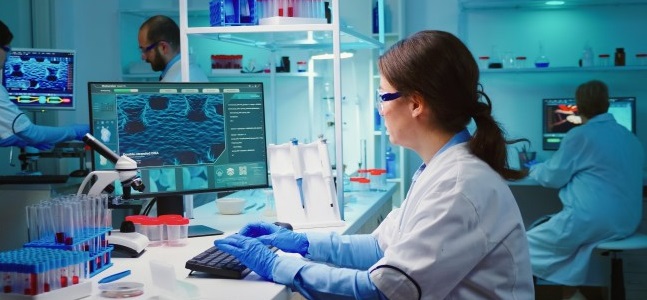Did you know that a mother’s body carries the cells of her child long after pregnancy ends? This phenomenon is called fetal microchimerism. This means that cells from the baby, containing the father’s DNA, remain within the mother’s body for decades.
What is Microchimerism?
Microchimerism is the presence of a small number of cells (or just DNA) within an individual, usually a mother from a baby. In pregnancy (Fetomaternal Microchimerism) cells are exchanged between a mother and fetus during pregnancy.
Other Common Sources of Microchimerism
Blood Transfusions: Donor cells can stay in a recipient long after a blood transfusion.
Organ Transplantation: Cells from a donated organ can migrate into the recipient’s body.

How does a father’s DNA move to the mother’s body?
A fetus is developed from the father and mother’s DNA. When cells are exchanged between mother and baby, some DNA of the father moves in the mother’s body. In pregnancy cells between the baby and mother exchange via the placenta. The placenta is a temporary organ that forms inside the uterus during pregnancy.
The placenta is the lifeline for a developing baby. It helps in nutrient delivery, waste removal, and hormone production and protects babies from infections.
Some fetal cells can travel. They pass through the placenta tiny openings that allow some fetal cells or father DNA to move in the mother’s body. Mother cells also reach the fetus by some immune cells or blood cells from the mother.
The father’s DNA stays in the mother for 27 years
According to research by D W Bianchi and others in 1996, male fetal cells or DNA of the father remain in the mother’s blood for as long as 27 years after the birth of the baby. This study investigated the presence of male fetal cells in women years after giving birth to a son. It’s considered a comprehensive research into fetal microchimerism.
Fetal cells have been found in a variety of organs and tissues in mothers after childbirth. Mostly baby cells are detected in the liver, brain, thyroid, bone marrow, and skin of the mother. However, the number of fetal cells which persist in a mother’s body is typically very small. Technology is improving, which has improved detection techniques over some time enabling more accurate identification of these cells and research is continuing.
Fetal cells have advantages for the mother
These aids wound healing and tissue repair in the mother:
- Fetal stem cell-like properties: Some fetal cells that migrate into the mother might possess stem cell-like qualities. Stem cells can differentiate into different cell types and are important for tissue regeneration and repair.
- Migration to injury sites: Studies suggest that fetal cells are attracted to injured tissues in the mother. This could be because those injured sites release signals that draw the fetal cells.
- Direct cellular repair: Once at the site of injury, fetal cells might transform into the type of cell needed for repair (muscle, skin, etc.) and directly help with tissue regeneration.
- Indirect repair support: Fetal cells might produce substances that promote healing and tissue repair. These substances could stimulate the mother’s cells or help create an environment favourable to healing.
- Heart Conditions: There are hints that fetal cells might even aid in repairing cardiac tissues in mothers after injuries like heart attacks.
Fetal cells lead to disease in the mother
There is a link between microchimerism (especially fetal microchimerism) and the development of certain autoimmune diseases. It is a complex and active area of research. There are different theories in this matter.
- Misidentification of “Self”: Autoimmune diseases occur when the immune system mistakenly attacks the body’s tissues. Fetal cells in a mother’s body carry the genetic material of the baby’s father that’s different from the mother. Sometimes the mother’s immune system misidentifies these fetal cells as dangerous cells and launches an attack. This attack might then spread to the mother’s tissue that shares similarities with the fetal cells.
- Molecular Mimicry: Some fetal cells produce proteins that are similar to proteins found in the mother’s tissues. The immune system becomes confused and begins attacking both the fetal cells and the similar components in the mother’s tissues which leads to an autoimmune response.
When the mother’s immune system attacks fetal cells, it can create different diseases in the mother which are still in research. It is important to note that not every cell of fetal microchimerism leads to autoimmunity. It’s likely that certain genetic predispositions and other environmental factors also play a significant role in determining who develops autoimmune diseases.
Conclusion:
Fetal microchimerism reveals that a mother carries cells of her child within her body for decades after birth. These fetal cells contain DNA from the father and may play a role in tissue repair and wound healing.
However, there’s also a potential link between fetal microchimerism and the development of autoimmune diseases. This phenomenon shows the long-lasting biological connection between mother and child. It also emphasizes the need for further research to understand its full implications.
FAQs:
During pregnancy, there’s a natural exchange of cells between the mother and the fetus. Some of the fetus’s cells, which contain DNA from both the mother and father, can move into the mother’s body and remain for years. Research shows father’s DNA stays in the mother’s blood for 27 years.
Studies suggest the father’s DNA might linger in a mother’s body through fetal microchimerism for up to 27 years after childbirth. This is based on research that detected male fetal cells in women’s blood after delivery.




